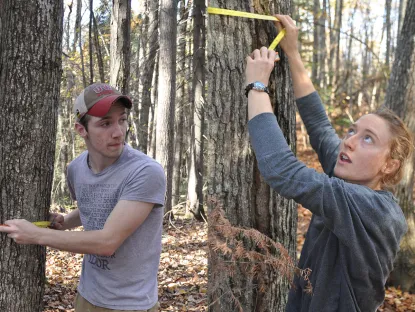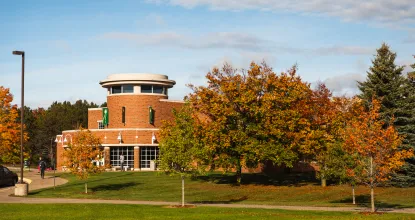
Naito discusses teaching opportunities at Dead River Community Forest as part of Upper Peninsula Land Conservancy Annual Meeting.
February 24, 2022
Dr. Adam T. Naito was invited to present at the Upper Peninsula Land Conservancy (UPLC) Annual Meeting on Wednesday, February 23, and discuss teaching opportunities afforded by the Dead River Community Forest.
In August 2021, Andrea Denham, the executive director of UPLC contacted EEGS to request logistical support as part of their fundraising efforts to acquire two parcels of forest along the Dead River. These parcels will become part of the future Dead River Community Forest (DRCF). The DRCF will exist for natural conservation and recreation purposes, as well as serving to promote the local economy. There are six (6) main objectives for development of this forest, one of which includes "initiating a climate-change mitigation- and restoration-focused management plan." In addition, should acquisition be successful, there are plans to involve students at NMU in projects that relate to its development and for future research.
As Dr. Naito was developing a 400-level course in biogeography for the Fall 2021 semester at the time, he devised a class laboratory exercise that would provide preliminary support for this mitigation and restoration strategy. In this exercise, undergraduate students in the biogeography course would identify the trees present in the forest, and through the use of basic forest measurements, estimate the biomass (the total mass of plant material above ground minus the water) of the larger trees. These biomass estimates can represent the amount of carbon sequestered (stored) on the Earth’s surface. As carbon storage potential of a plot of land increases, its ability to mitigate human-induced climate change also generally increases. Older and larger trees tend to be better able to remove carbon dioxide out of the atmosphere.
Dr. Naito took his students in this biogeography course to DRCF twice in October 2021 to collect data. Connor O'Loughlin (ENV-NRES) and Ally West (ENV-NRES), two of the 10 students, is pictured to the right collected diameter data. They spent the next month processing and analyzing the data, and they developed a report to UPLC summarizing these findings. The intention was that these preliminary data could support their fundraising efforts and provide a "proof-of-concept" that students at NMU would benefit from the opportunities presented by the forest because we proved in advance that students did benefit. This is an example of a service-learning project because the data supports a local non-profit agency that has connections with the public and NMU, and students learned practical techniques employed by biogeographers, vegetation ecologists, and foresters. With improvements, their work can provide a foundation for more in-depth work in the future that will enhance community engagement activities.
Read The Mining Journal's report on this meeting.
To watch the Annual Meeting presentations, visit UPLC's YouTube Channel or visit the research project website.
